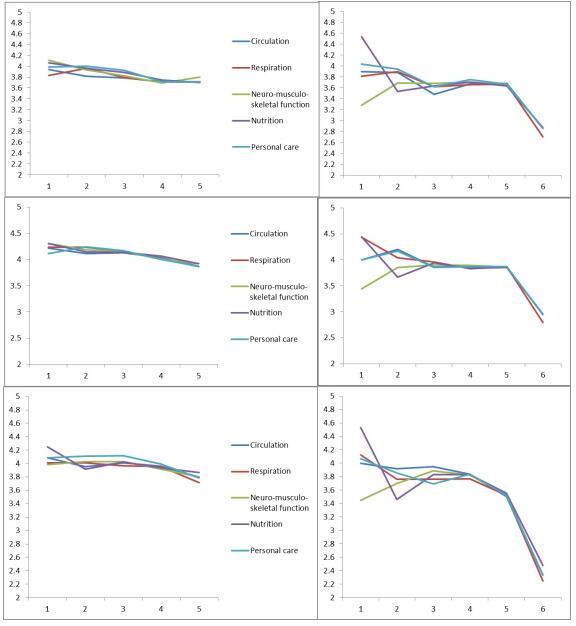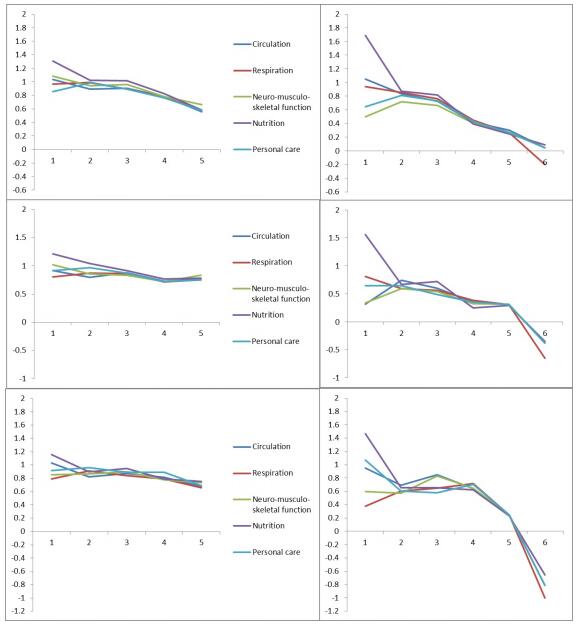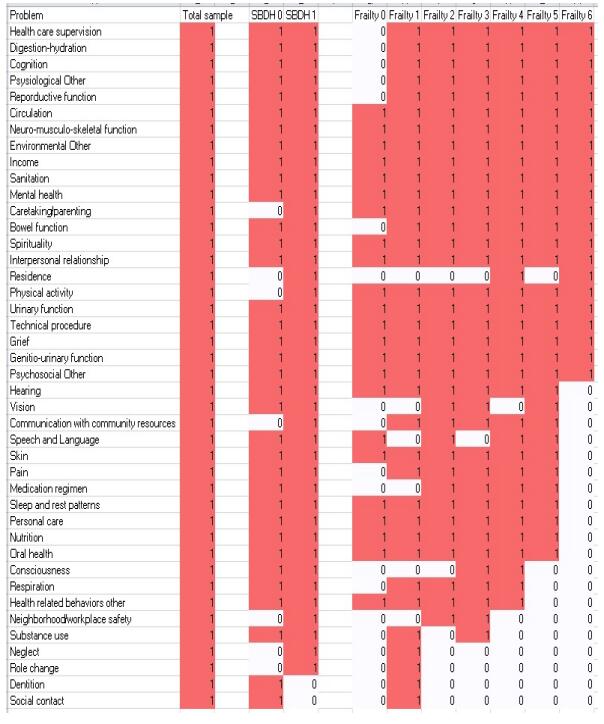1. Background
Optimizing healthy aging and healthy wellbeing are high priorities in healthcare and research due to rapid growth in aging populations in the U.S. and globally [18,14,15]. Because the proportion of the population in the older ages is increasing relative to other ages, the U.S. along with many other countries is becoming an aging nation [5]. By 2060, the projected increase in this population will be at 98 million, equivalent to 23.5% of the U.S. population; more than doubling the estimated population number of 2014 [5]. Trends in aging are accompanied by similar trends in the prevalence of chronic illness in older adults and associated costs in healthcare [15]. Chronic illness represents 75% of annual U.S. health care spending [15]. In recent years, the Institute of Medicine (IOM) has strived to develop and implement cross-cutting strategies to reduce burdens of chronic illness by calling attention to enhance quality of life for individuals living with chronic illnesses [15]. To find cross-cutting strategies to improve health requires better understanding of who needs help, what helps, and when is the best time to help to improve the function and quality of life for older adults living with chronic illness.
2. Frailty
In contrast to a best achievable state of health, frailty embodies health deficits and deterioration often associated with aging that prevents a healthy state of living [6,12]. Frailty is typically conceptualized as a clinical syndrome characterized by decreased energy, strength, performance and increased vulnerability to physical and functional decline [6,12]. Frailty among older adults increases health deficits and risk of hospitalization [10]. Frailty has been shown to predict health status, functional decline, and health service utilization [3,21,23]. Frailty due to social and behavioral determinants of health (SBDH) may be reversible with intervention [4,26]. Frailty is a clinical syndrome [6] characterized by physical, cognitive, psychological, and functional declines in connection with advancement in aging. In studies, frailty is often operationalized by a frailty index which measures accumulative variations of cognitive, psychological, and physical health deficits across multi-dimensions [4,26,1,2,8]. These measures include comorbidities related to cognition, disease, and nutrition as well as function affecting activities of daily living. Such measures point toward variations and deficits in comorbidities and activities of daily living that affect cognitive, psychological, and physical health of an individual [4,26,1,2,8].
3. Social and behavioral determinants of health
According to the World Health Organization (WHO), determinants of health consist of multiple factors including the social and economic environment, the physical environment, and the person's individual characteristics and behaviors [20]. The circumstances in which people are born, grow, live, work, and age characterizes the social determinants of health [19]. Such social conditions are mostly determined by the distribution of finances, power, and resources in society that create health inequities in health status of individuals [19]. Behavioral determinants of health include risk and/or protective behaviors as well as responses to health problems [7]. Studies that look at the impact of SBDH on frailty find multi-dimensional associations of social and behavioral factors with frailty [4,26]. These factors include education, marital status, living arrangements, smoking status, alcohol use, income, social contact, and physical activity. Measures to universally assess SBDH in electronic health records (EHRs) have been recommended by the IOM [16,17]. The Omaha System [9] is a comprehensive and holistic standardized terminology that can be used to capture the multi-dimensional frailty measures and SBDH. It has been used in community care settings to document assessments, interventions, and outcomes of older adults [9]. Mappings to the SBDH measures recommended by IOM [16,17] have been completed and operationalized using the Omaha System [16]. Both SBDH and frailty can be classified using Omaha System metrics and may be used to examine relationships in home care data [6,11]. To enable intervention development and potentially improve the health of frail older adults, research is needed to explore the relationships between SBDH and frailty for community-dwelling older adults. This study examined associations between SBDH and frailty from a sample of home care data generated during routine documentation for older adults using the Omaha System. The objective of this study was to identify hidden patterns in the data relative to SBDH and frailty.
4. Methods
4.1. Design
This study reused an existing Omaha System dataset to perform an exploratory data analysis of any associated pattern in health outcomes of frail vs. non-frail older adults relative to SBDH. This study was exempted from review by the University of Minnesota Institutional Review Board.
4.2. Sample
The current study reused existing data from 1,618 home care records for patients with ages greater than 65 that included Omaha System problems, interventions, and Knowledge (K), Behavior (B), and Status (S) outcomes. Eight agencies contributed an average of 202 patient records to the dataset; the numbers of records per agency ranged from 92-399.
4.3. Instrument and metrics
The Omaha System is a standardized language, interface terminology, and measure designed to enhance practice, documentation, and information management across settings [9]. It consists of three components including the Problem Classification Scheme, the Intervention Scheme, and the Problem Rating Scale for Outcomes. The Problem Classification Scheme has 42 problem concepts within Environmental, Psychosocial, Physiological and Health-related Behaviors Domains. This component offers both a structured problem list and standardized vocabulary to capture nursing assessments (problem-specific strengths and signs/symptoms). The Intervention Scheme, which is related to the Problem Classification Scheme, provides structure and standardized vocabulary to address each problem and document nursing care plans and services. It has three hierarchical levels including 4 Categories (action terms), and 75 Targets and customized Care Descriptions that further specify interventions. The Problem Rating Scale for Outcomes measures the Problem concepts using three 5-point Likert-type scales pertaining to the severity of Knowledge, Behavior, and Status concepts (1 = lowest to 5 = highest). Knowledge indicates what an individual understands, Behavior describes how an individual acts, and Status defines the severity of signs/symptoms for an identified Problem concept. Each of the KBS rating scales presents a continuous evaluation framework for assessing and evaluating an individual's problem-specific rating over time. The reliability and validity of the Omaha System components have been tested and established in multiple settings in research [9].
An existing Omaha System metric for SBDH was operationalized based on the IOM-recommended measures [16,17] using mapped Omaha System problems summed into a possible score ranging from 0-6 [11]. The following Problem concepts from the Problem Classification Scheme of the Omaha System were included to construct the SBDH metric: Income, Social contact, Mental health, Abuse, Physical activity, and Substance use (Table 1). Based on the sample distribution, individuals with an SBDH score of 0 was assigned to SBDH Group 0 and those with SBDH score from 1 to 6 were allocated to SBDH Group 1.
Table 1. Social and Behavioral Determinants of Health Index and Omaha System Problem Concept Items (Adapted from Monsen et al., 2017).
| IOM-Recommended Domain | Omaha System Problem Concept | Items Present in the Data 1 = yes; 0 = no |
| Stress/Depression | Mental health (N=134) | 1 |
| Physical activity | Physical activity (N=106) | 1 |
| Financial resource strain | Income (N=12) | 1 |
| Social connections/social isolation | Social contact (N=4) | 1 |
| Tobacco use and exposure/Alcohol use | Substance use (N=1) | 1 |
| Intimate partner violence | Abuse | 0 |
| Total problems in the dataset = 5 (Possible Score = 6) |
An Omaha System metric for frailty of older adults was based on the objective criteria developed by Fried et al. [6] and operationalized using Omaha System Problems concepts from the Problem Classification Scheme summed into a score of 0-6. These Problem concepts were Consciousness, Circulation, Respiration, Nutrition, Personal care, and Neuro-musculo-skeletal function (Table 2). Based on the sample distribution, frailty groups were evaluated as a continuum for each point of the Frailty score rather than the dichotomous frailty vs. non-frailty categorization as originally designated by Fried and colleagues [6].
Table 2. Frailty Index and Omaha System Problem Concept Items.
| Frailty Objective Criteria (Fried et al., 2001) | Omaha System Problem Concept | Items Present in the Data 1 = yes; 0 = no |
| Weakness (grip strength)/ Slow walking speed | Neuro-musculo-skeletal function (N=1036) | 1 |
| Self-reported exhaustion | Circulation (N=634) | 1 |
| Self-reported exhaustion | Respiration (N=526) | 1 |
| Unintentional weight loss (10 lbs in past yr) | Nutrition (N=425) | 1 |
| Low physical activity | Personal care (N=379) | 1 |
| Low physical activity | Consciousness (N=3) | 1 |
| Total problems in the dataset = 6 (Possible Score = 6) |
4.4. Pattern detection from line graphs
Visualization methods including line graphs were created using Excel to explore associations between SBDH and frailty overall and by problem. Visual examination of the images was used to identify hidden patterns, and hypotheses were generated based on these patterns. Paired samples t-tests (overall outcomes) and two-way ANOVA tests (differences by problem, frailty, and SBDH) were further performed to evaluate the hypotheses.
5. Results
5.1. Sample characteristics
The sample of 1,618 health records were divided into SBDH Group 0 (n = 1397) and SBDH Group 1 (n = 221). The average age for SBDH Group 0 was 79.9 years (SD = 7.66). 63.5% of this sample was female. The average age for SBDH Group 1 was 81.04 years (SD = 7.27). 65.6% of this sample was female. SBDH Group 0 was significantly younger (p = .04); there was no difference in distribution by gender. There was overall improvement in KBS for the entire sample and by SBDH group after home care intervention (Table 3).
Table 3. Average final Knowledge, Behavior, and Status scores on admission and discharge.
| KA | KD | BA | BD | SA | SD |
| SBDH Group 0 | 2.95 | 3.95 | 3.26 | 4.22 | 3.10 | 4.01 |
| SBDH Group 1 | 3.01 | 3.83 | 3.34 | 3.99 | 3.13 | 3.89 |
| Difference | -.06 | .12 | -.12 | .23 | -.03 | .12 |
| p-value | 0.188 | 0.013 | 0.043 | < 0.001 | 0.540 | 0.025 |
| Note: KA = Knowledge score at admission; KD = Knowledge score at discharge; BA = Behavior score at admission; BD = Behavior score at discharge; SA = Status score at admission; SD = Status score at discharge; SBDH = Social and Behavioral Determinants of Health. |
5.2. Pattern detection and validation
Exploratory analysis of average final and change outcomes by SBDH and frailty groups revealed different patterns by problem (Figures 1 and 2), with notable differences by frailty scores. In general, SBDH Group 0 scores show little difference by problem and by frailty score, decreasing slightly as frailty scores increase. In contrast, SBDH Group 1 patterns show markedly greater decreases as frailty scores increase, with differing problem patterns, especially for the Nutrition problem. We tested these patterns using two-way ANOVA analysis (Table 4). Results showed that SBDH group, Frailty, and SBDH-Frailty interaction were important for understanding outcomes for Final Knowledge, final Status, and change in Knowledge, Behavior, and Status. For final Behavior, SBDH group and Frailty were important. These outcomes varied in significance by problem, except for change in Status (Table 4). The greatest number of significant interaction between SBDH and frailty was observed across outcomes of the Circulation and Nutrition problems. Visualization of problem percentages for SBDH Groups by Frailty using heat maps showed that the Mental health problem was the most common of the SBDH problems and was consistent across frailty groups (Figure 3). Other patterns were observed including a similar prevalence of problems across Frailty scores 2-5, and Residence problem distribution in only the higher Frailty groups (Figure 4).
Table 4. Significance of Outcomes by Frailty, SBDH, and Problem (non-significant p values in bold font).
| Outcome | Circulation |
| Frailty | SBDH | Interaction |
| Final K | < .001 | .001 | .739 |
| Final B | < .001 | < .001 | .039 |
| Final S | < .001 | < .001 | < .001 |
| Change K | < .001 | < .001 | .001 |
| Change B | < .001 | < .001 | .000 |
| Change S | < .001 | < .001 | < .001 |
|
| Outcome | Respiration |
| Frailty | SBDH | Interaction |
| Final K | < .001 | .003 | .613 |
| Final B | < .001 | < .001 | .355 |
| Final S | .009 | .159 | .107 |
| Change K | < .001 | < .001 | .001 |
| Change B | < .001 | < .001 | .002 |
| Change S | < .001 | < .001 | .004 |
|
| Outcome | Neuro-musculo-skeletal function |
| Frailty | SBDH | Interaction |
| Final K | < .001 | < .001 | < .001 |
| Final B | < .001 | < .001 | < .001 |
| Final S | < .001 | < .001 | .415 |
| Change K | < .001 | < .001 | .366 |
| Change B | < .001 | < .001 | .892 |
| Change S | < .001 | < .001 | .001 |
|
| Outcome | Nutrition |
| Frailty | SBDH | Interaction |
| Final K | < .001 | < .001 | .702 |
| Final B | < .001 | < .001 | .681 |
| Final S | < .001 | < .001 | .009 |
| Change K | < .001 | < .001 | .000 |
| Change B | < .001 | < .001 | < .001 |
| Change S | < .001 | < .001 | < .001 |
|
| Outcome | Personal care |
| Frailty | SBDH | Interaction |
| Final K | < .001 | < .001 | .724 |
| Final B | < .001 | < .001 | .854 |
| Final S | < .001 | < .001 | .049 |
| Change K | < .001 | < .001 | .028 |
| Change B | < .001 | < .001 | .158 |
| Change S | < .001 | < .001 | .002 |
| Note: K = Knowledge; B = Behavior; S = Status; SBDH=Social and Behavioral Determinants of Health. |
6. Discussion
This exploratory data analysis study of existing documentation for older adults revealed important patterns in the data. Overall, older adults improved after receiving home care services. There was differential improvement by SBDH, frailty, and problem, with significant interaction between frailty and SBDH for most SBDH problems. The Omaha System-based metrics were useful in normalizing SBDH and frailty to facilitate this discovery. Findings should be validated through replication with other datasets. Further research is needed to extend this method to other populations and settings.
Results revealed in the line graphs for the total sample and by SBDH group demonstrate improved KBS outcomes for older adults after interventions. Worse outcome scores as the frailty index score increases suggests that when older adults become increasingly frail is consistent with the literature [12]. It is not known whether nursing intervention may reverse problems contributing to frailty. Further research is needed to determine if more effective nursing interventions targeted towards older adults in the early stage of frailty could reverse progressive frailty. Another pattern was manifested by the negative associations between frailty scores and KBS outcomes. As frailty scores increased, KBS outcomes decreased. Such a trajectory demonstrated a possible continuum of increasing frailty as related co-morbidities accrued. This finding concurs with the correlations of higher frailty scores obtained by a different instrument and more comorbid illnesses in another study [22]. This perspective on frailty should be further investigated to guide practice and research.
The difference of improvement in KBS outcomes for frail older adults suggests that SBDH matters in KBS outcomes relative to the frailty index level and SBDH factors matter in the health outcomes of older adults. Interventions leveraged at lowering the SBDH factors in older adults could also contribute to achieving better health outcomes for these individuals. The differences in these trends between these two SBDH groups have at least two implications. One implication is that SBDH matters in the KBS outcomes for older adults. Another implication is that for older adults affected by SBDH, when frailty advances to a certain degree, it complicates older adults' KBS outcomes.
The Mental health problem pattern finding suggests that in this sample, Mental health problems largely defines SBDH Group 1. Related SBDH issues represented by the Omaha System Problem of Mental health from the SBDH metric are stress and depression. This aligns with the literature on the impact of mental health on overall health and wellbeing. According to WHO, an individual's position on the social gradient is closely associated with one's life expectancies and the occasions of diseases [25]. As one moves further down the social ladder, such social circumstances place an individual under great stress, and stress exert negative impacts on one's health [13]. Research also suggests that a mental health issue such as depression not only produces the greatest decline in health in comparison with chronic diseases such as angina, arthritis, asthma, and diabetes [24], but also is a risk factor for developing a wide range of cardiovascular diseases [22]. This study suggests similar negative impacts of these mental health issues on health outcomes within the context of different older adults' projected levels of frailty. Further analysis of patterns that may be present based on heat map visualizations is planned regarding priority problems that are prevalent for frail older adults, and the likelihood of Residence issues related to frailty.
Two common approaches of conceptualizing and operationalizing frailty are based on either a deficit model to create a frailty index by summing up an individual's number of impairments and conditions or categorization of pre-frail, frail, or non-frail by using a physical phenotype [6] consisting of 5 possible components [12]. The findings suggest that frailty should be examined on a continuum to conceptualize and operationalize frailty as an accumulative progression that advances and may be ameliorated or resolve with intervention. Such a frailty index offers an opportunity to discover more specific factors over time that account for what contributes to frailty and its trajectory. Further research is needed to replicate this study with other datasets and to further refine the SBDH and Frailty indexes.
The limitations of this study include the usual limitations of large observational datasets in that no controls could be imposed and therefore it is not possible to infer causation from the analysis. The naturalistic data generated in the practice setting was obtained prior to the IOM-recommended SBDH documentation guidance, and SBDH problems were infrequent in the data; in fact, only 5 of the 6 problems were present (Table 1). In alignment with recommendations of the IOM, all SBDH problems should be assessed during routine home care documentation [9,16].
7. Conclusion
This exploratory study identified relationships between SBDH and frailty for older adults in home care services using Omaha System data. This study shows improvement in KBS outcomes of older adults overall, with decreasing outcomes as frailty increases. In this sample, Mental health was predominantly responsible for SBDH Group membership, and further research is needed to understand the associations between Mental health problems. Improved documentation of SBDH problems is needed to increase confidence in future research reusing documentation data to facilitate better understanding of SBDH and associations between SBDH and frailty. Further research is needed to validate the findings and to evaluate the metrics with other datasets and populations.









 DownLoad:
DownLoad: 










